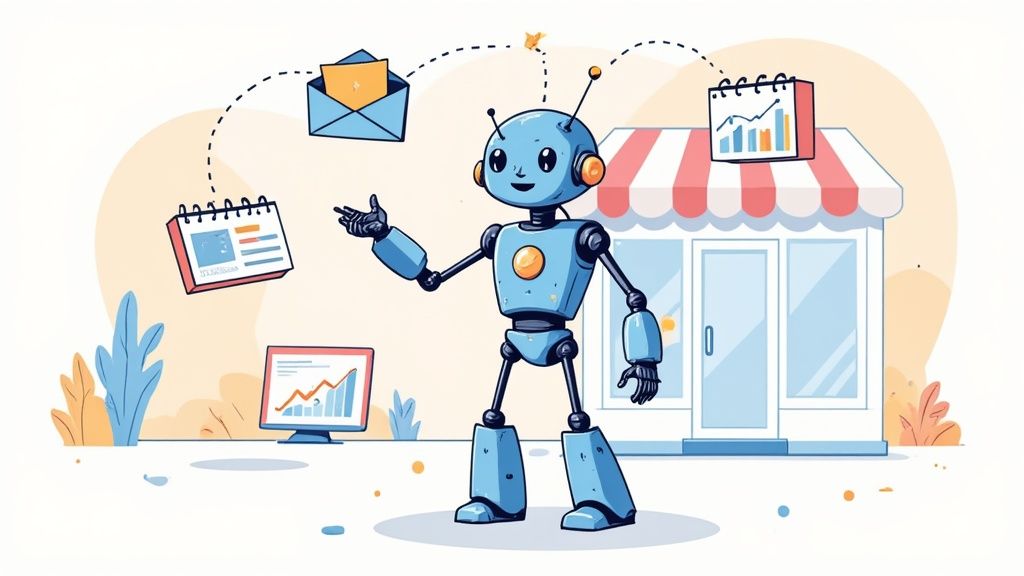Marketing automation software is your secret weapon for handling those repetitive, time-sucking marketing tasks. It saves you a ton of time while making sure your customers feel seen and cared for.
Think of it as the most reliable employee you've ever had—one who works around the clock sending welcome emails, posting on social media, and following up on leads, all without you having to do a thing. It’s a system built to help you get more done with the team you have.
What Is Marketing Automation Anyway?
Let’s say you run a small coffee shop. A new customer signs up for your loyalty program on their phone. In that instant, an automated system sends them a "Welcome!" email with a 10% off coupon for their next latte. If they don't pop back in within two weeks, the system gives them a friendly nudge with a reminder email. That entire sequence just happens, building a connection from day one.
That’s small business marketing automation in a nutshell. It’s not about being robotic or losing that personal touch. It’s about letting technology handle the predictable stuff so you can pour your energy into the creative strategy and genuine interactions that actually grow your business. You set the rules once, and the system runs on its own in the background.
Moving Beyond Manual Tasks
Without automation, your daily to-do list is a beast. You're constantly trying to remember to post on Facebook, manually update email lists, and send individual follow-ups to new leads. These tasks are critical, but they drain your most precious resource: time.
Marketing automation organizes these jobs into simple, streamlined "workflows."
- Trigger: Something happens to kick things off. A customer might fill out a form, visit a specific page on your site, or leave items in their shopping cart.
- Action: Based on that trigger, the software does something you've already told it to do. This could be sending an email, adding them to a specific customer segment, or notifying your sales team.
- Timing: You're in complete control of the when. An action can be instant, delayed for a few days, or even scheduled to happen only during business hours.
This trigger-and-action model makes sure every potential customer gets the right message at the right time—a feat that's nearly impossible to pull off manually once you start to grow.
Marketing automation is your secret weapon for consistency. It guarantees every customer gets the same high-quality experience, whether they're your first lead of the day or your hundredth.
A Practical Example in E-Commerce
Imagine you sell handmade jewelry online. A shopper adds a beautiful necklace to their cart but gets distracted and leaves your site. Instead of that sale vanishing into thin air, an automated workflow kicks in.
An hour later, an email lands in their inbox: "Did you forget something?" complete with a gorgeous picture of the necklace. If they still don’t buy, maybe another email follows a day later with a small discount to seal the deal. The visual appeal here is everything, which is why professional product photo editing services can make these automated reminders incredibly effective.
And it gets even smarter. The next step is understanding how AI marketing automation can layer intelligence onto these campaigns. This technology can actually predict which customers are most likely to buy and tailor offers just for them.
Ultimately, marketing automation isn't just a time-saver. It’s about creating smarter, more personal customer journeys at a scale that allows even the smallest businesses to compete with the big players.
Why Automation Is a Game-Changer for Small Businesses
Knowing what automation does is one thing. Seeing how it can completely change the day-to-day reality of running a small business is another. As a small business owner, your time is your most guarded asset, and every dollar has a job to do. This is where small business marketing automation stops being a buzzword and becomes your secret weapon for survival and growth.
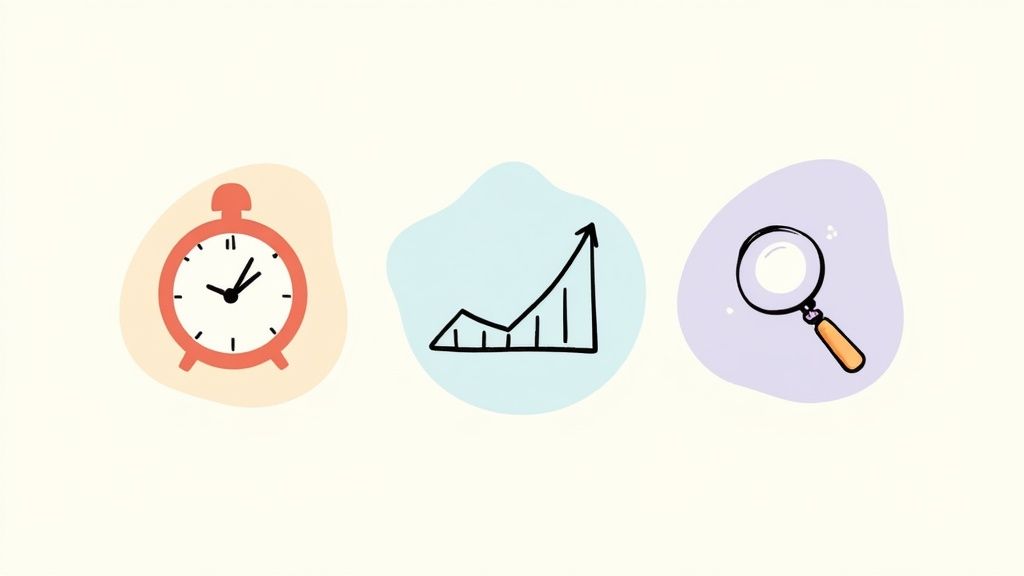
Think of it as reclaiming your focus. Instead of getting bogged down in the manual grind of sending follow-up emails, scheduling a dozen social media posts, or painstakingly segmenting contact lists, you build systems that run on their own. This hands you back the hours you need to focus on strategy, build real customer relationships, and dream up the big-picture ideas that no software can ever replace.
Boost Efficiency and Do More with Less
Let's be real—your "marketing department" is probably just you, or maybe a tiny team juggling a dozen other roles. Automation is the ultimate force multiplier. It lets you run a sophisticated marketing machine that would normally take a whole crew of people to manage.
Take a local bakery, for instance. An automated workflow can send a personalized birthday discount to every single customer on their special day. That one simple, automated touch builds incredible loyalty and drives repeat sales, all without the owner lifting a finger after the initial setup. It’s about delivering consistent, professional marketing without the burnout.
Automation isn't about replacing the human touch; it's about scaling it. It ensures every customer feels valued through timely, personalized communication, even when you're busy running the business.
This efficiency pays off immediately. By nurturing leads automatically, you make sure no potential customer ever falls through the cracks. Anyone who shows interest gets the right information at the right time, guiding them smoothly from a curious visitor into a vocal fan of your brand.
Drive Revenue with Smarter Communication
One-size-fits-all marketing is dead. Generic messages just get ignored. The real power of automation is its ability to segment your audience based on how they behave, what they're interested in, and their history with your business.
This opens the door to sending targeted campaigns that actually connect with people.
- For new leads: A consultant can set up an email series that educates prospects, building trust and positioning them as an expert.
- For recent buyers: An e-commerce shop can automatically send a follow-up email a week later asking for a review or suggesting a perfectly matched complementary product.
- For your biggest fans: A local service business can create an exclusive list for repeat clients, giving them first dibs on new offers.
These tailored conversations aren't just nice to have—they lead directly to higher engagement and more sales. You're no longer shouting into a void; you're having relevant conversations with the right people when it matters most.
A Strategic Investment with Compounding Returns
Setting up your first automation system isn't just another expense—it's a strategic investment that pays you back over and over. The numbers don't lie. In fact, for every dollar spent on marketing automation, businesses see an average return of $5.44, a clear indicator of its incredible ROI.
This is why over 70% of companies are already using automation to sharpen their marketing, and why 91% of decision-makers say requests for these tools are on the rise. It’s simply becoming the cost of entry for staying competitive. You can explore more insights on 2025 marketing automation trends to see just how critical this is becoming.
In the end, small business marketing automation isn't just about saving time. It's about building a business that's more resilient, more scalable, and ultimately, more profitable. It delivers compounding returns—in your growth, and just as importantly, in your own sanity.
The Best Places to Start Automating Your Marketing
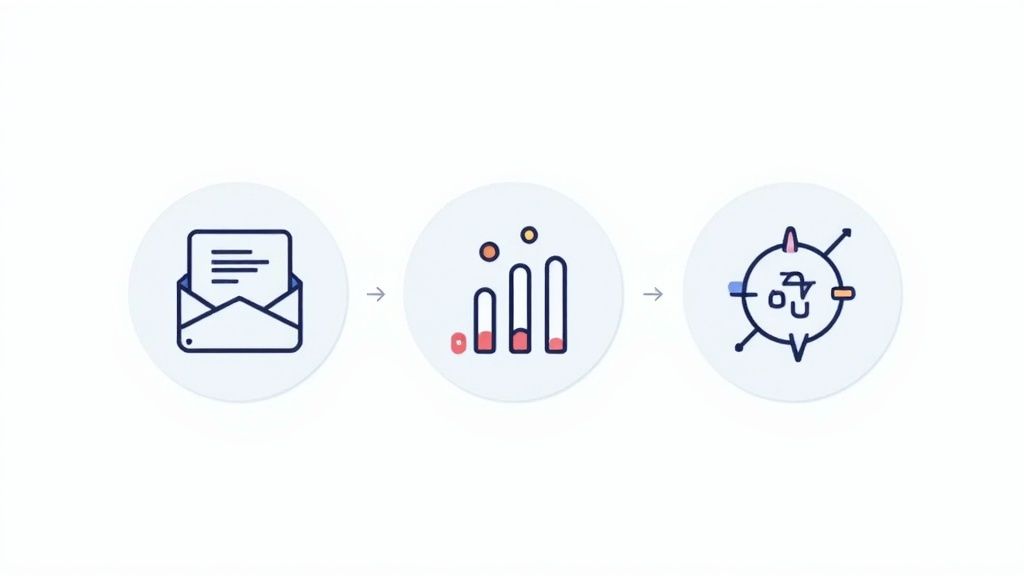
Jumping into marketing automation can feel like standing at a massive buffet, not knowing where to fill your plate first. The secret? Start with the tasks that save you the most time and give you the biggest wins right away. For a small business, that means focusing on high-impact activities that build relationships and drive sales without getting tangled in a complicated setup.
Instead of trying to automate everything all at once, just pick a few signature dishes to master first. These are the automations that offer immediate relief and real, visible results. By targeting a few specific areas, you turn the big, abstract idea of "automation" into a clear, manageable to-do list.
Looking at all the options, here are some of the most common and impactful areas where small businesses are finding success with automation.
Top Automation Opportunities for Small Businesses
| Marketing Area | Automated Task Examples | Primary Benefit |
|---|---|---|
| Email Marketing | Welcome series for new subscribers, abandoned cart reminders, birthday/anniversary emails. | Builds customer relationships automatically and nurtures leads consistently. |
| Social Media | Scheduling posts across multiple platforms, monitoring brand mentions. | Frees up time from manual posting, ensures a consistent online presence. |
| Lead Management | Scoring leads based on behavior, assigning hot leads to the sales team. | Focuses sales efforts on the most engaged prospects, increasing conversion rates. |
| Content & SEO | Distributing new blog posts to email/social channels, tracking keyword rankings. | Maximizes the reach of your content and keeps SEO efforts on track. |
| Customer Service | Automated responses to common questions, post-purchase follow-up surveys. | Improves customer satisfaction and gathers valuable feedback without manual effort. |
Each of these areas solves a real problem for small business owners—saving time, improving consistency, and making sure no opportunity falls through the cracks. Let's dig into the three best places to get started.
Master Your Email Marketing First
If there’s one place to begin, it’s with email. It’s the trusty workhorse of digital marketing, giving you a direct line to your audience and a massive opportunity for personalization. It’s no surprise that email marketing leads automation adoption, with 58% of marketers automating email campaigns in 2024—way ahead of other channels.
You can start with something as simple as a welcome series. When someone new subscribes, an automated sequence can kick in:
- Instantly send a warm welcome and confirm they’re on the list.
- A day later, share your most popular blog post or a killer tip.
- After three days, offer a small discount or a free guide.
This simple workflow makes sure every new subscriber gets a consistent, engaging experience, building trust from the moment they sign up. It’s a powerful way to make a great first impression without you having to lift a finger for each person.
Automate Your Social Media Presence
Managing social media can feel like a hamster wheel of creating, scheduling, and posting. This is a perfect spot for automation to step in and give you your time back. With a scheduling tool, you can plan and line up a week's—or even a month's—worth of content in one go.
The system then posts everything for you at the best times for each platform. This frees you from the daily scramble of “What should I post today?” and lets you focus on engaging with your audience in real time as the comments and questions start rolling in.
Automation transforms your social media strategy from reactive to proactive. You spend less time on the mechanics of posting and more time on the meaningful work of community building.
Streamline Your Lead Management
How do you know which new leads are ready to talk sales and which ones need a bit more warming up? Automation can figure this out for you with lead scoring. A system can automatically give points to leads based on what they do—like opening an email, visiting your pricing page, or downloading a resource.
Once a lead hits a certain score, the system can ping you or your sales team, letting you know it’s time to reach out. This smart process makes sure you’re focusing your energy on the most promising prospects, which can dramatically boost your efficiency and conversion rates. It turns your website from a static brochure into an active part of your sales process. A great way to start is by looking at foundational tasks, like finding ways to automate your keyword research process.
Ultimately, starting with these three core areas—email, social media, and lead management—builds an incredibly strong foundation. Each one solves a common headache for small businesses and delivers tangible results that will give you the momentum and confidence to tackle even bigger automation projects down the road.
Choosing the Right Automation Tools Without Breaking the Bank
Stepping into the world of small business marketing automation can feel a bit like walking into a massive electronics store. There are endless options, flashy features, and confusing price tags everywhere you look. It's easy to get overwhelmed.
But here’s the good news: you don’t need the most expensive, feature-packed tool on the shelf to get incredible results.
The real key is finding a platform that fits your business right now—your specific needs, your budget, and where you plan to grow. Many of the best tools are built with small businesses in mind, offering free plans or affordable starting points. You can get your feet wet without a huge financial commitment. The goal is to make a smart choice that starts working for you from day one.
And there's never been a better time. While large companies currently hold a 62.5% market share, small and medium-sized businesses (SMEs) are the fastest-growing segment, with a projected compound annual growth rate of 15.2% through 2030. This boom is happening because accessible software with freemium tiers has finally put powerful automation within reach for everyone. You can discover more insights about marketing automation statistics on inbeat.agency.
Focus on Your Core Needs First
Before you get lost comparing a dozen different features, stop and ask yourself one simple question: "What is my biggest marketing headache right now?"
Your answer is your compass. It will point you to the right category of tools. Don't get roped into paying for a massive all-in-one suite with a dozen features you won't touch for another year. Instead, match the tool to the job you need done today. It saves money and a whole lot of frustration.
Here’s a quick breakdown of common needs and the types of tools that solve them:
- Best for Email Marketing Beginners: If you're just trying to build an email list and send out newsletters, platforms like Mailchimp or ConvertKit are perfect. They have friendly interfaces and fantastic free plans to get you rolling.
- Top All-in-One for Growth: When you're ready to connect email, customer management (CRM), and landing pages, tools like HubSpot or ActiveCampaign are the next step. Their starter plans are built to grow with you.
- Most Affordable for E-commerce: For online stores, platforms like Klaviyo are a game-changer. They’re built to plug directly into Shopify and other e-commerce sites, specializing in things like abandoned cart reminders and post-purchase follow-ups.
Key Factors to Consider in Your Search
Once you know what kind of tool you need, it’s time to weigh your options. Look past the marketing hype and focus on the practical stuff that will actually affect your daily work and your budget.
A beautiful dashboard is worthless if it’s too confusing to use. The right platform should feel intuitive and make your life easier, not harder.
Your marketing automation tool should feel like a helpful assistant, not another complicated job you have to manage. Prioritize ease of use and solid customer support above all else.
As you compare platforms, keep these four critical factors in mind:
- Scalability: Does the tool have a clear growth path? Make sure you can upgrade to a more powerful plan without the nightmare of switching to a whole new provider later on.
- Integrations: Will it play nicely with the other software you already use? Think about your website builder, e-commerce platform, or social media scheduler.
- Ease of Use: Is the interface clean and easy to figure out? Always sign up for a free trial and try building a simple workflow. See how it feels.
- Pricing Model: Get clear on how they charge you. Is it based on your number of contacts, how many emails you send, or which features you unlock? Pick a model that makes sense for your business goals.
For small businesses wanting to use video without a big budget, exploring Top Free AI Video Generator Tools can be a great place to start. And if your marketing leans heavily on great visuals, it’s smart to understand the cost of professional product photography so you can budget for high-quality images to use in your automated campaigns. Making these kinds of savvy, budget-aware decisions from the get-go will set you up for success down the road.
How to Build Your First Automated Workflow
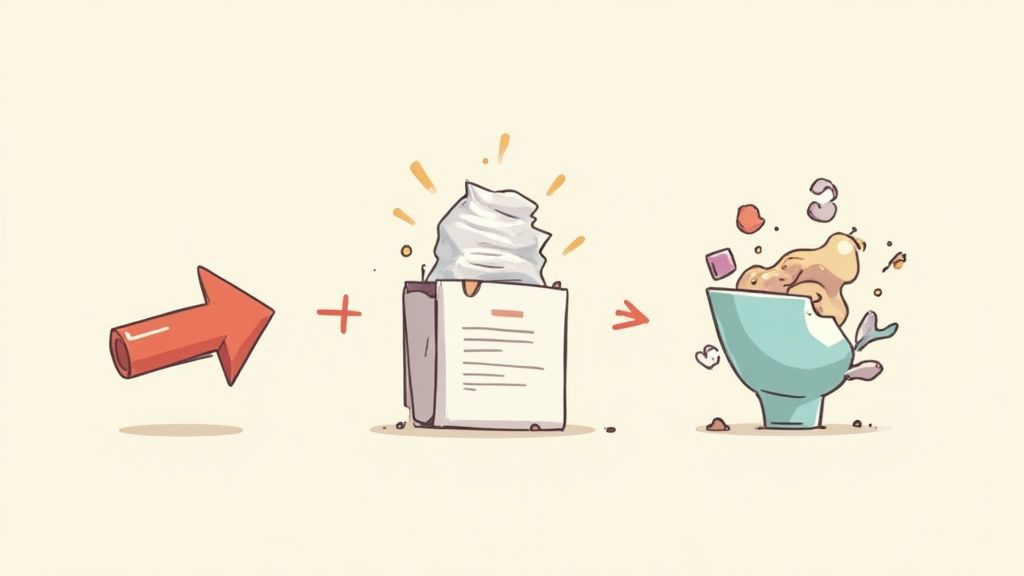
Theory is one thing, but actually building something yourself is where the real learning happens. So let's roll up our sleeves and create your very first piece of small business marketing automation. We're going to build a simple but incredibly effective workflow that every business needs: a new subscriber welcome series.
I'll break it down into six clear, manageable steps. By the end, you'll see just how achievable this is. The goal here is to take automation from a big, scary concept and turn it into a simple, actionable plan you can start using right away.
Step 1: Define Your Goal
Before you even think about logging into a tool, you have to know why you're doing this. What's the point of this automation? A fuzzy goal like "engage new subscribers" won't cut it. You need to be specific.
For a welcome series, a sharp goal looks like this: "To build a relationship with new subscribers by sending three helpful emails over five days, ending with a special 15% discount to drive their first purchase." See the difference? This goal gives your workflow a clear purpose and a way to measure if it's actually working.
Step 2: Pick Your Trigger
Every automation needs a "go" button—an event that kicks the whole thing off. This is your trigger. Think of it as the starting pistol for your workflow. It's the moment the software gets the signal to start running the sequence.
For a welcome series, the trigger is one of the most common and straightforward in marketing.
- The Trigger: Someone fills out and submits a form on your website. This could be your newsletter sign-up, a lead magnet download, or a pop-up offer.
This is a perfect place to start. It's a clear action a person takes to show they're interested, making it the ideal moment to start a conversation.
Step 3: Map the Sequence
Now for the fun part: sketching out the journey. This doesn't need to be some complex diagram. A simple list or a few boxes on a whiteboard is all you need to decide what happens and when.
A classic welcome sequence might look like this:
- Immediately: Send Email #1 (The Welcome). This email should confirm their subscription and deliver whatever you promised them.
- Wait 2 Days: Send Email #2 (The Value). Share something genuinely useful, like your most popular blog post, a quick tip, or your brand's origin story.
- Wait 3 Days: Send Email #3 (The Offer). This is where you introduce your special offer to nudge them toward that first purchase.
Mapping this out helps you see the flow from your customer's perspective and makes sure the timing feels natural, not aggressive.
Think of your automated sequence as a friendly conversation, not a sales pitch. Each step should build on the last, adding value before asking for a sale. This approach builds trust, which is the foundation of customer loyalty.
Step 4: Craft Your Messages
With your map in hand, it's time to write the actual emails. Keep your brand's voice consistent across all of them and stay laser-focused on the goal for each specific message.
- Email #1 (Welcome): Keep it short, sweet, and to the point. Welcome them, give them what they signed up for, and let them know what to expect next.
- Email #2 (Value): Don't sell a thing. Your only job here is to be helpful. This builds major goodwill and proves you're not just another company trying to push products.
- Email #3 (Offer): You've earned a little trust, so now you can present your offer. Make your call-to-action crystal clear and give them a compelling reason to act.
Step 5: Build and Test It
Okay, now you can log into your automation software. Using the platform's workflow builder—which is usually a simple drag-and-drop interface—you'll recreate the sequence you just mapped out. Set your trigger, add your time delays, and drop in your email content.
But wait—don't hit "publish" just yet. Testing is critical. Sign up for your own list with a test email. Go through the entire experience just like a new subscriber would. Look for typos, broken links, or weird timing. This is how you catch those small, embarrassing mistakes before they go out to your entire audience.
Step 6: Go Live and Monitor
Once you've tested everything and it's all working perfectly, it's time to set it live. Congrats! You just built your first marketing automation workflow.
But your job isn't quite done. For the first week or so, keep a close eye on performance. Are people opening the emails? Are they clicking the links? Watching the initial results will tell you if everything is working correctly and give you a baseline to improve upon later.
How to Measure and Improve Your Automation Success
Getting your first automated workflow live is a great feeling, but that's just the starting line. The real magic of small business marketing automation happens when you treat it like a living, breathing part of your strategy—something you constantly measure, tweak, and improve.
Think of it less like a finished painting and more like a garden. You can't just plant the seeds and walk away; it needs regular attention to really flourish. This is how you go from just saving time to actively driving better results. By keeping an eye on a few key numbers, you can quickly see what’s resonating with your audience and what’s falling flat, letting you make smart changes that show up on your bottom line.
This infographic lays out the whole process perfectly, showing how you turn automated actions into real, measurable returns.
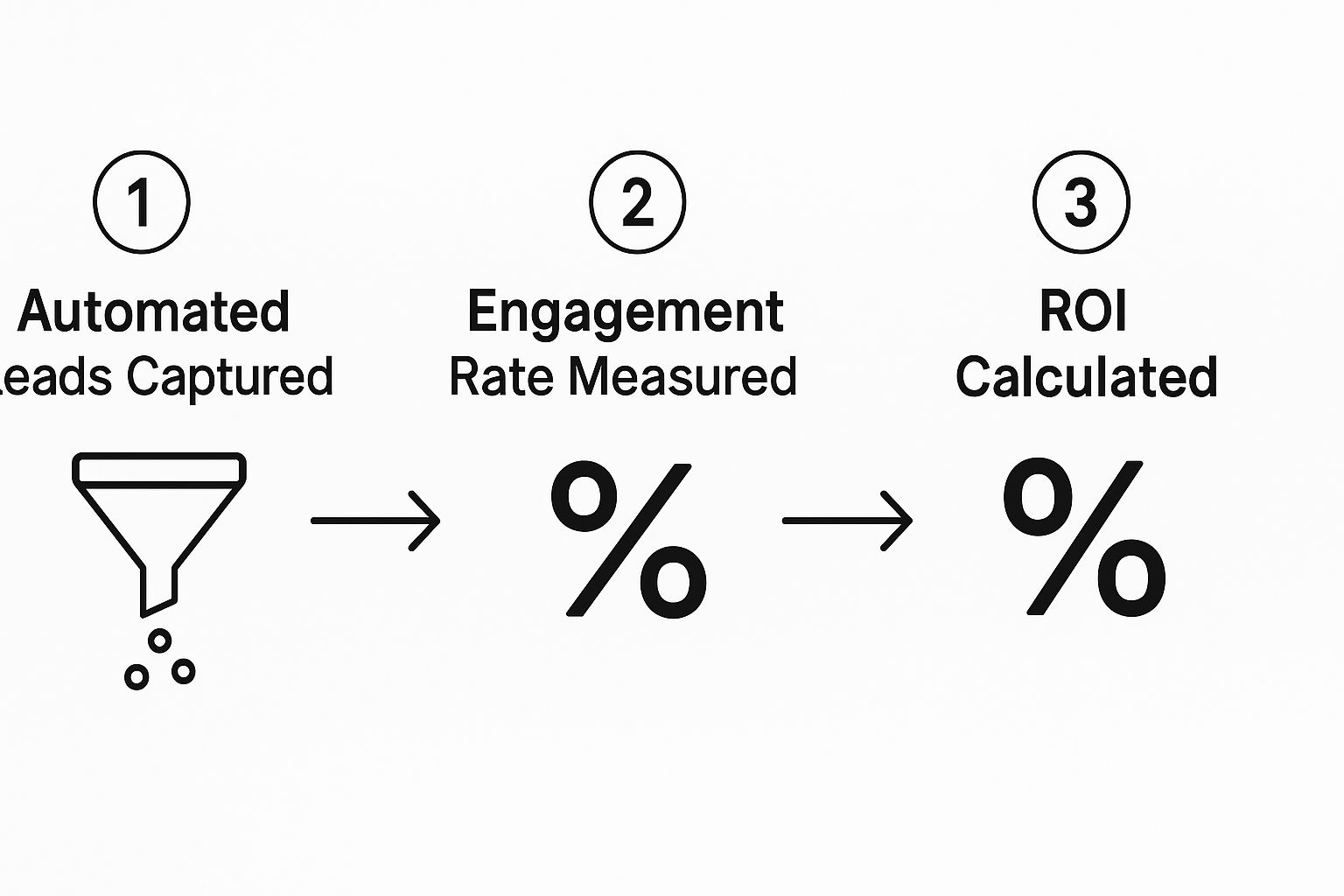
As you can see, it all starts with bringing in new leads, then you track how they interact, and finally, you get a clear picture of your return on investment.
Key Metrics to Watch
You don't need a PhD in data science to figure this out. For most small businesses, a handful of essential metrics will tell you almost everything you need to know, especially when it comes to your email workflows.
Start by focusing on these three:
- Open Rate: It’s simple: what percentage of people actually opened your email? A low number here is a big red flag that your subject line isn't grabbing anyone's attention.
- Click-Through Rate (CTR): Of the people who opened your email, how many clicked a link inside? If your CTR is low, it’s a sign your message didn't connect or your call-to-action wasn't clear enough.
- Conversion Rate: This is the big one. What percentage of people took the action you wanted them to take, like buying something or signing up? This is where the money is.
Turning Insights into Action
Once you have this data, you can start making real improvements. This is where you graduate from simply using automation to truly optimizing it.
Your data tells a story about what your audience wants. The key to improvement is listening to that story and adjusting your approach accordingly. If a campaign underperforms, it’s not a failure—it’s feedback.
Here are a few practical ways to boost your results based on what the numbers are telling you:
- If Open Rates Are Low: It's almost always the subject line. Run an A/B test with a couple of different versions. Try one that asks a question, one that uses an emoji, or one that creates a little urgency. See what works.
- If CTR Is Poor: The problem is inside the email. Your call-to-action (CTA) might be buried or boring. Make it more direct. Your visuals could also be the culprit. For e-commerce stores, amazing product images are non-negotiable, which is why many lean on professional photo editing services for ecommerce to make their products look irresistible.
- If Conversions Are Lagging: You need to look at the whole customer journey. After they click, where do they land? Is the page confusing? Is the offer compelling? Tiny adjustments to your landing page can make a huge difference in getting people to follow through.
Of course. Here is the rewritten section, crafted to sound human-written and match the provided expert style:
Common Questions About Marketing Automation
Jumping into small business marketing automation usually kicks up a few last-minute questions. It’s smart to get these sorted out before you dive in, because having a clear head is the first step to getting real results. Let’s walk through the biggest concerns I hear from small business owners.
One of the first things people ask about is the price tag. There’s this idea that automation is a luxury reserved for big corporations with bottomless budgets. The truth is, the market is now full of affordable tools, and many of them have seriously powerful free plans to get you started. The trick is to begin with a simple platform that can grow with you, instead of overpaying for a bunch of features you won’t even touch yet.
Will It Make My Marketing Feel Impersonal?
This is a big one. Small business owners worry they’ll lose that personal touch that makes them special. It's a totally valid fear, but good automation should actually boost your personal connection, not kill it. Instead of just blasting out generic newsletters, you can set it up to automatically send a happy birthday discount or a follow-up email based on what a customer actually looked at on your site.
Automation is there to handle the timing and the delivery. You are still the one who controls the message. A well-crafted automated email that shows up at just the right moment can feel way more personal than a generic, one-size-fits-all newsletter ever could.
Finally, I hear a lot of anxiety about the tech side of things. "Do I need to be some kind of coding genius to make this work?" Absolutely not. Modern tools are built for regular people, with drag-and-drop editors and simple, step-by-step guides. You don't need to write a single line of code to get a powerful workflow up and running.
Think of it this way:
- Is it expensive? Only if you pick a tool that’s too big for your business right now.
- Is it impersonal? Only if you write bland, generic messages. The tool is just the messenger.
- Is it complicated? Not anymore. The best platforms are built for business owners, not developers.
If you start with one clear goal and a simple, focused workflow, you can easily sidestep these common worries and start seeing the benefits almost immediately.
Ready to transform your product photos without the hassle? ProdShot uses AI to turn simple smartphone pictures into stunning, professional-quality images in seconds. Try it for free and see how incredible visuals can elevate your marketing. Get your professional product shots today at ProdShot.

